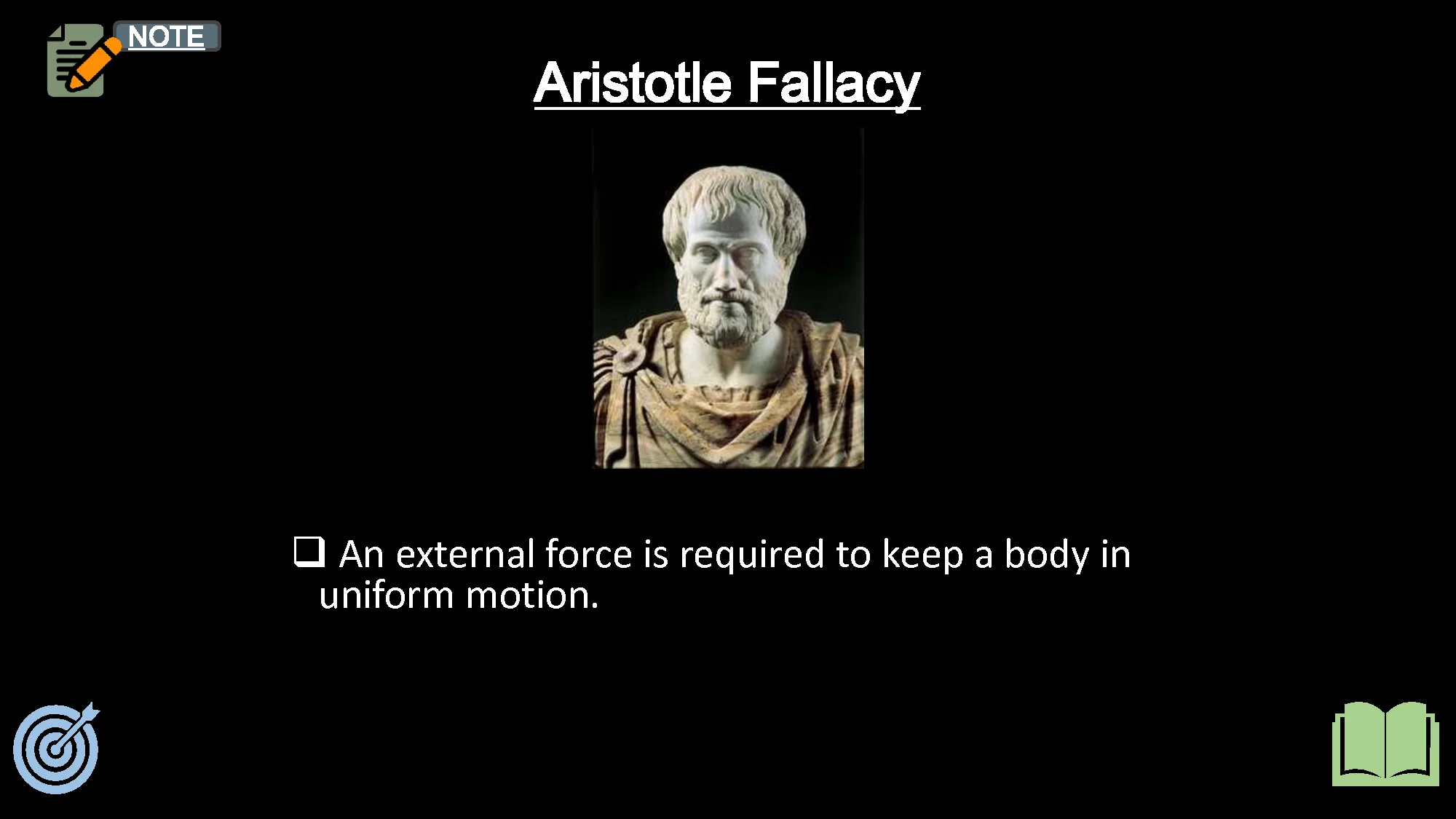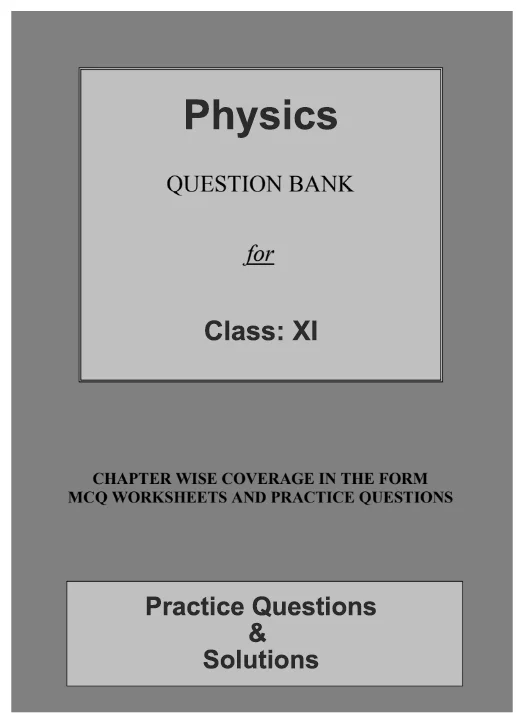Law of Motion: Aristotle’s fallacy
In the rich tapestry of philosophical thought, Aristotle's contributions stand as pillars of classical wisdom. However, even the most revered minds are not immune to fallacies. This blog ventures into the exploration of Aristotle's fallacy, peeling back the layers of his influential reasoning to reveal moments where even the great philosopher may have faltered.
Aristotle’s Fallacy
Returning to the example quoted above, we talk about the toy car, which must be dragged as long as we want it to be in motion. Once you leave the string loose, the car comes to rest. Similarly, you roll a ball on the floor. It eventually slows down and then comes to rest. If you want the car or the ball to move again, you need to pull the string or roll the ball again. In other words, you need to apply force on them.
So Aristotle made observations from practical experiences and came to the conclusion that an external force is required to keep a body in uniform motion. This is known as Aristotle’s fallacy.

Is an External Force Required to Keep a Body in Uniform Motion?
The simple and sweet answer would be NO. But let us discuss the reason behind calling Aristotle’s observation a fallacy.We know that a moving toy car comes to rest. But the actual reason behind it is the presence of the frictional force that the car experiences due to its contact with the floor. It is friction that opposes its motion and eventually brings it to rest. So now, when you apply the force in the direction of the car’s motion, you basically overcome or counter the frictional force to set the car into motion again.
It is interesting to note that, had there not been any frictional force, there was no force required to keep the car moving. This implies that in the absence of an external opposing force, a body in motion will be in uniform motion forever. Aristotle failed to understand this and set his argument based on practical experiences only. This is why it is called Aristotle’s fallacy.
CBSE Class 11th Downloadable Resources:
| 1. CBSE Class 11th Topic Wise Summary | View Page / Download |
| 2. CBSE Class 11th NCERT Books | View Page / Download |
| 3. CBSE Class 11th NCERT Solutions | View Page / Download |
| 4. CBSE Class 11th Exemplar | View Page / Download |
| 5. CBSE Class 11th Previous Year Papers | View Page / Download |
| 6. CBSE Class 11th Sample Papers | View Page / Download |
| 7. CBSE Class 11th Question Bank | View Page / Download |
| 8. CBSE Class 11th Topic Wise Revision Notes | View Page / Download |
| 9. CBSE Class 11th Last Minutes Preparation Resources | View Page / Download |
| 10. CBSE Class 11th Best Reference Books | View Page / Download |
| 11. CBSE Class 11th Formula Booklet | View Page / Download |
Being in CBSE class 11th and considering the board examinations you must be needing resources to excel in your examinations. At TestprepKart we take great pride in providing CBSE class 11th all study resources in downloadable form for you to keep you going.
Below is the list of all CBSE class 11th Downloads available on TestprepKart for both Indian and NRI students preparing for CBSE class 11th in UAE, Oman, Qatar, Kuwait & Bahrain.
SAMPLE PRACTICE QUESTIONS OF SIGNIFICANT FIGURES :
Q1: What are Aristotle's fallacies?
A1: Aristotle's fallacies are errors in reasoning identified by the ancient Greek philosopher Aristotle. He categorized them into two main types: formal fallacies, which arise from the logical structure of an argument, and informal fallacies, which stem from issues with the content or language of the argument.
Q2: What is the difference between formal and informal fallacies?
A2: Formal fallacies involve errors in the logical structure of an argument, rendering it invalid. Informal fallacies, on the other hand, involve mistakes in the content or language of the argument, making it unsound.
Q3: Can you provide examples of formal fallacies?
A3: Sure, examples of formal fallacies include the fallacy of affirming the consequent and the fallacy of denying the antecedent. These errors occur when the structure of the argument is flawed, leading to invalid conclusions.
Q4: What are some examples of informal fallacies?
A4: Informal fallacies include ad hominem attacks, strawman arguments, and appeals to emotion. These errors arise from problems with the content or language of the argument, rather than its logical structure.
Q5: Why is it important to recognize fallacies in arguments?
A5: Recognizing fallacies is crucial for critical thinking and effective communication. Identifying errors in reasoning helps in constructing and evaluating sound arguments, leading to more informed decision-making.

| Class 11th CBSE Physics Chapters |
| Chapter1: UNITS AND MEASUREMENTS |
| Chapter2: MOTION IN A STRAIGHT LINE |
| Chapter3: MOTION IN A PLANE |
| Chapter4: LAWS OF MOTION |
| > Introduction |
| > The law of inertia |
| > Newton’s first law of motion |
| > Newton’s second law of motion |
| > Newton’s third law of motion |
| > Conservation of momentum |
| > Equilibrium of a particle |
| > Common forces in mechanics |
| > Circular motion |
| > Solving problems in mechanics |
| Chapter5: WORK, ENERGY AND POWER |
| Chapter6: SYSTEM OF PARTICLES AND ROTATIONAL MOTION |
| Chapter7: GRAVITATION |
| Chapter8: MECHANICAL PROPERTIES OF SOLIDS |
| Chapter9: MECHANICAL PROPERTIES OF FLUIDS |
| Chapter10: THERMAL PROPERTIES OF MATTER |
| Chapter12: KINETIC THEORY |
| Chapter13: OSCILLATIONS |
| Chapter14: WAVES |
| Class 11th CBSE Chemistry Chapters |
| Chapter1: SOME BASIC CONCEPTS OF CHEMISTRY |
| Chapter2: STRUCTURE OF ATOMS |
| Chapter3: CLASSIFICATION OF ELEMENTS AND PERIODICITY IN PROPERTIES |
| Chapter4: CHEMICAL BONDING AND MOLECULAR STRUCTURE |
| Chapter5: THERMODYNAMICS |
| Chapter6: EQUILIBRIUM |
| Chapter7: REDOX REACTIONS |
| Chapter8: ORGANIC CHEMISTRY – SOME BASIC PRINCIPLE AND TECHNIQUES |
| Chapter9: Hydrocarbons HYDROCARBONS |
| Class 11th CBSE Mathematics chapters |
| Chapter1: SETS |
| Chapter2: RELATIONS AND FUNCTIONS |
| Chapter3: TRIGONOMETRIC FUNCTIONS |
| Chapter4: COMPLEX NUMBER AND QUADRATIC EQUATIONS |
| Chapter5: LINEAR INEQUALITIES |
| Chapter6: PERMUTATIONS AND COMBINATIONS |
| Chapter7: BINOMIAL THEOREM |
| Chapter8: SEQUENCES AND SERIES |
| Chapter9: STRAIGHT LINES |
| Chapter10: CONIC SECTIONS |
| Chapter11: INTRODUCTION TO THREE-DIMENSIONAL GEOMETRY |
| Chapter12: LIMITS AND DERIVATIVES |
| Chapter13: STATISTICS |
| Chapter14: PROBABILITY |
| Class 8 Link soon |
| Class 9 Link soon |
| Class 10 Link soon |
| Class 12 Link soon |

Leave a Reply